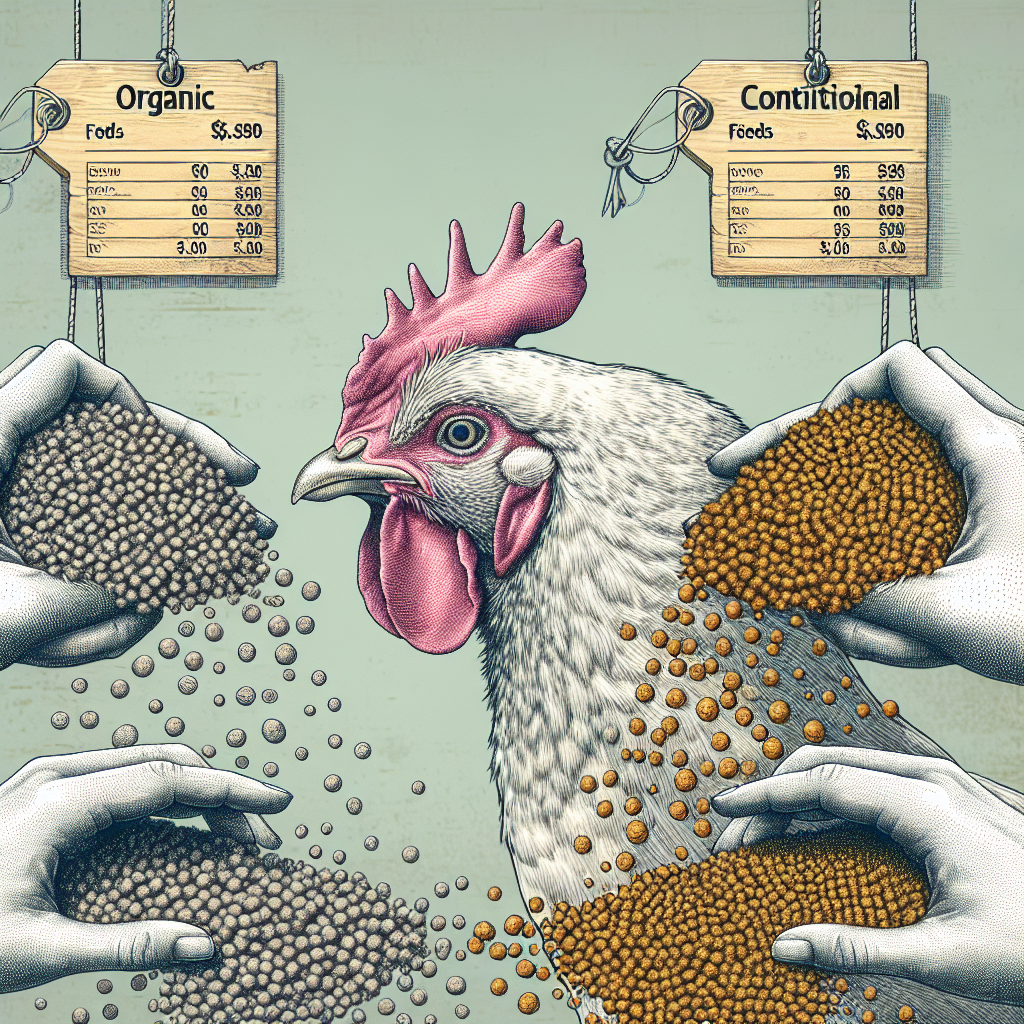When it comes to feeding your chickens, the decision between organic and conventional chicken feeds can be quite a dilemma. Not only are you concerned about providing the best nutrition for your beloved flock, but you also need to consider the financial implications of your choice. In this article, we will explore the cost implications when choosing between organic and conventional chicken feeds, giving you a clearer understanding of the benefits and drawbacks of each option. From pricing to quality, we’ve got you covered! So, grab a cup of tea and get ready to make an informed choice that nourishes both your chickens and your budget.
Organic Chicken Feeds
When it comes to choosing between organic and conventional chicken feeds, there are several factors to consider. One of the main considerations is the difference in ingredient costs. Organic feeds typically use higher quality and more expensive ingredients compared to conventional feeds. While this may lead to higher prices for organic chicken feeds, many consumers believe that the added benefits are worth the extra cost.
Higher Ingredient Costs
The main reason for the higher ingredient costs in organic chicken feeds is the use of certified organic ingredients. Organic farming practices require the use of organic seeds and feeds, which are typically more expensive than conventionally produced alternatives. Organic feeds often include organic grains such as corn and soybeans, which are more costly to produce due to the lack of synthetic pesticides and fertilizers used in their cultivation.
Certification Costs
Apart from the higher ingredient costs, organic chicken feeds also involve certification costs. Organic farming practices must adhere to specific guidelines and standards set by certifying bodies. These certifications ensure that the feed is produced in a manner that meets organic standards, including the avoidance of synthetic inputs and genetically modified organisms (GMOs). The certification process can be time-consuming and expensive, adding to the overall cost of organic feeds.
Potential Benefits for Consumers
Despite the higher costs, there are potential benefits for consumers who choose organic chicken feeds. Organic feeds are believed to result in healthier chickens, which in turn may produce higher-quality meat and eggs. The use of organic ingredients also means that the feed may have a higher nutritional value compared to conventional feeds. Additionally, organic farming practices have a reduced environmental impact, making it a more sustainable choice for consumers who prioritize eco-friendly options.
Conventional Chicken Feeds
On the other hand, conventional chicken feeds offer some advantages, including lower ingredient costs and potentially lower pricing for consumers. However, it is important to consider the potential health risks associated with conventional feeds.
Lower Ingredient Costs
Conventional chicken feeds generally use lower-cost ingredients compared to organic feeds. These ingredients may include conventionally grown grains that are often produced using synthetic pesticides and fertilizers. The lower ingredient costs make conventional feeds more affordable for farmers and can result in lower prices for consumers. However, it is important to weigh the potential health risks associated with these ingredients.
Potential Health Risks
Conventional chicken feeds may pose certain health risks due to the use of antibiotics, hormones, and pesticide residues. Antibiotics are commonly used in conventional farming to prevent and treat diseases in animals. However, this can lead to antibiotic resistance, which is a concern for public health. Hormones may also be used in conventional feeds to promote growth in chickens, but this practice is banned in organic farming. Moreover, pesticide residues from conventionally grown grains and other ingredients can potentially end up in the chicken meat or eggs, raising concerns for consumers.
Lower Pricing for Consumers
One of the main advantages of conventional chicken feeds is the lower pricing for consumers. The lower ingredient costs contribute to lower overall production costs for farmers. As a result, conventional chicken products are generally more affordable for consumers, making it a preferred choice for those on a tighter budget. However, it is essential to consider the potential health risks and environmental impact associated with conventional farming practices.
Ingredient Costs
When comparing the ingredient costs between organic and conventional chicken feeds, there are notable differences that influence the overall pricing.
Organic Feed Ingredients
Organic chicken feeds prioritize the use of certified organic ingredients, which come at a higher cost. These ingredients are typically grown without synthetic pesticides, herbicides, or fertilizers. Organic grains, such as corn and soybeans, are commonly used in organic feeds, and their cultivation follows strict organic guidelines. The higher cost of organic feed ingredients is a reflection of the added expenses involved in producing these ingredients using organic farming practices.
Conventional Feed Ingredients
Conventional chicken feeds, on the other hand, often include conventionally grown grains that are produced using synthetic inputs. These ingredients may be less expensive due to the higher yields and lower production costs associated with conventional farming methods. However, the lower cost of conventional feed ingredients does not necessarily indicate a better value, considering potential health risks and environmental concerns.
Price Comparison
Due to the higher ingredient costs in organic chicken feeds, they are generally priced higher compared to conventional feeds. The added expenses involved in producing and sourcing organic ingredients, as well as the certification costs, contribute to the higher price tag. However, there is a growing market demand for organic products, and many consumers are willing to pay the premium for the perceived benefits and assurance of organic farming practices.
Certification Costs
Certification costs also play a significant role in determining the pricing of organic and conventional chicken feeds.
Organic Certification
In order to label a feed as “organic,” it must adhere to specific guidelines and standards set by certifying bodies. These certifications ensure that the feed meets the requirements for organic farming practices, including the use of organic ingredients, avoidance of synthetic inputs, and adherence to strict animal welfare standards. Obtaining organic certification requires inspections, audits, and compliance with regulations, all of which add to the overall costs of producing organic feeds.
Conventional Certification
Conventional chicken feeds do not require specific certifications, as the ingredients used are not subject to the same organic farming standards. However, conventional farming practices may still involve certifications related to general food safety and quality control. While these certifications may have their own associated costs, they are typically less stringent compared to organic certifications.
Impact on Pricing
The certification costs involved in producing organic feeds contribute to their higher pricing. These costs are necessary to ensure compliance with organic standards and provide assurance to consumers. While conventional feeds may not have the same certification requirements, the potential health risks associated with conventional farming methods should also be taken into account when assessing the overall value and pricing of chicken products.
Potential Benefits of Organic Feeds
Despite the higher costs, organic feeds offer potential benefits that may appeal to consumers who prioritize health, nutrition, and sustainability.
Healthier Chickens
Organic feeds are believed to result in healthier chickens overall. The use of organic ingredients eliminates the exposure to synthetic pesticides, herbicides, and genetically modified organisms. Additionally, the avoidance of antibiotics and hormones in organic feeds reduces the risk of antibiotic resistance and potential hormonal imbalances in the chickens. Healthier chickens may lead to higher-quality meat and eggs for consumers.
Higher Nutritional Value
Organic feeds are often made from high-quality organic grains, which may have a higher nutritional value compared to conventionally grown grains. The use of organic farming practices, such as the enrichment of soil with natural fertilizers, can enhance the nutrient content of the grains. As a result, organic chicken products may offer a higher nutritional value in terms of essential vitamins, minerals, and antioxidants.
Reduced Environmental Impact
One of the key advantages of organic farming practices is their reduced environmental impact compared to conventional farming methods. Organic feeds prioritize sustainable practices, such as the use of natural fertilizers and the preservation of soil health. By avoiding the use of synthetic pesticides and fertilizers, organic farming helps protect water sources, soil quality, and biodiversity. Choosing organic feeds can contribute to a more sustainable food system and reduce the overall environmental footprint.
Demand and Pricing
The increasing demand for organic products, including organic chicken feeds, also plays a role in the pricing. As more consumers choose organic options, the economies of scale may eventually lead to lower prices. However, in the current market, the limited supply and higher production costs associated with organic feeds contribute to their higher pricing. Consumers willing to pay the premium for organic feeds often value the assurance of organic farming practices and the potential health and environmental benefits.
Potential Health Risks of Conventional Feeds
While conventional chicken feeds may offer lower pricing, they come with potential health risks that consumers should consider.
Use of Antibiotics
Conventional farming practices often involve the use of antibiotics to prevent and treat diseases in animals. This routine use of antibiotics can lead to antibiotic resistance, a major global health concern. Antibiotic-resistant bacteria can be transmitted to humans through the consumption of meat or eggs from animals that have been treated with antibiotics. This raises concerns for consumers who prioritize food safety and minimizing the risk of antibiotic resistance.
Hormone Use
In conventional farming, hormones may be used in chicken feeds to promote growth and increase productivity. However, the use of hormones in poultry farming is banned in organic farming practices. Some consumers may be concerned about the potential hormonal imbalances that could arise from consuming meat or eggs from animals raised on hormone-treated feeds.
Pesticide Residues
Conventionally grown grains used in chicken feeds are often treated with synthetic pesticides to control pests and increase crop yields. While these pesticides are approved for agricultural use, there is a potential risk of pesticide residues remaining in the feed and ultimately ending up in the chicken meat or eggs. Consumers who prioritize minimizing exposure to pesticide residues may opt for organic feeds to avoid potential ingestion of these chemicals.
Consumer Concerns
Consumer awareness regarding the potential health risks associated with conventional feeds has been on the rise. Many individuals are becoming more conscious of their food choices and are actively seeking organic options as a way to minimize exposure to potentially harmful substances. The concerns surrounding antibiotics, hormones, and pesticide residues in conventional feeds have prompted some consumers to switch to organic alternatives.
Value for Consumers
Choosing between organic and conventional chicken feeds ultimately comes down to personal preferences and priorities. There are several factors that consumers may consider when evaluating the value of each option.
Quality and Taste
Many consumers believe that organic chicken products offer superior quality and taste compared to conventionally produced ones. The emphasis on organic ingredients and the avoidance of synthetic inputs can result in meat and eggs that are perceived to be of higher quality and more flavorful. However, taste preferences can be subjective, and some consumers may not notice a significant difference between organic and conventional chicken products.
Health Benefits
The potential health benefits associated with organic feeds, such as reduced exposure to antibiotics, hormones, and pesticide residues, may be an important consideration for health-conscious consumers. Choosing organic feeds can provide a sense of reassurance and peace of mind for those seeking to minimize potential health risks associated with conventional farming practices.
Budget Considerations
Budget constraints often play a significant role in consumer decision-making. Conventional chicken feeds generally offer lower pricing, making them more accessible for consumers on a tight budget. However, it is essential to weigh the potential health risks and long-term consequences associated with conventional feeds against the short-term cost savings.
Personal Preferences
Lastly, personal preferences may guide consumer choices when it comes to chicken feeds. Some individuals may have ethical or environmental concerns and opt for organic feeds to support sustainable farming practices and animal welfare. Others may prioritize convenience, availability, or local sourcing. Understanding and aligning with personal preferences is crucial when assessing the value of different options.
Environmental Impact
The environmental impact of chicken feeds is a significant consideration, as the agricultural industry plays a substantial role in greenhouse gas emissions and resource consumption.
Organic Farming Practices
Organic farming practices prioritize sustainability and environmental stewardship. These practices often involve the use of natural fertilizers, crop rotation, and integrated pest management. By avoiding the use of synthetic pesticides and chemical fertilizers, organic farming aims to protect biodiversity, soil health, and water quality. Choosing organic feeds can contribute to reducing the overall environmental footprint of chicken production.
Chemical Usage
Conventional chicken feeds rely on conventionally grown grains treated with synthetic pesticides and fertilizers. These chemicals can have negative impacts on the environment, including water contamination, soil degradation, and harm to non-target organisms. The use of organic feeds can help minimize chemical usage and its associated environmental consequences.
Sustainability
Sustainable agriculture is gaining importance as the global population continues to grow, putting pressure on natural resources. Organic farming practices, including the production of organic chicken feeds, align with the principles of sustainable agriculture. By promoting soil health, reducing chemical inputs, and protecting ecosystems, organic feeds contribute to a more sustainable food system.
Long-Term Consequences
Considering the long-term consequences of farming practices is essential for maintaining a healthy environment. While conventional feeds may be more cost-effective in the short term, the potential environmental consequences of chemical usage and unsustainable farming practices must be taken into account. By choosing organic feeds, consumers can support farming methods that prioritize long-term environmental sustainability.
Consumer Demand
Consumer preferences and market demand are crucial factors that influence the availability and pricing of organic and conventional chicken feeds.
Trends Favoring Organic
In recent years, there has been a significant increase in consumer demand for organic products. This trend is driven by various factors, including health consciousness, environmental concerns, and a desire to support sustainable farming practices. As a result, organic chicken feeds have become more readily available in many markets, catering to the growing demand.
Accessibility and Availability
The accessibility and availability of organic chicken feeds may vary depending on geographical location and market demand. Organic feeds are generally more common in areas with high consumer demand for organic products. However, as the market continues to expand, organic feeds are becoming increasingly accessible, even in regions where they were once scarce.
Economic Factors
The cost implications of producing organic feeds can influence their availability and pricing. The higher ingredient costs and certification expenses associated with organic feeds often result in higher price points. However, as the demand for organic products continues to grow and economies of scale come into play, the prices may become more competitive and accessible for a wider range of consumers.
Market Share
The market share of organic chicken feeds, compared to conventional feeds, is continuously evolving. As consumer preferences shift towards organic options, the market share for organic feeds is expected to increase. However, conventional feeds still dominate the market, particularly in regions where organic options are less readily available or more costly. The competition between organic and conventional feeds ultimately depends on consumer demand and the willingness to pay for the perceived benefits.
Conclusion
Choosing between organic and conventional chicken feeds involves considering various factors, including ingredient costs, certification expenses, potential health risks, and environmental impact. Organic feeds generally come with higher ingredient and certification costs, but they offer potential benefits such as healthier chickens, higher nutritional value, and reduced environmental impact. On the other hand, conventional feeds may offer lower pricing, but they are associated with potential health risks and environmental concerns.
Ultimately, the decision depends on personal preferences, budget considerations, and priorities. Health-conscious consumers may opt for organic feeds to minimize exposure to potential risks associated with conventional farming practices. Others may prioritize budget considerations and choose conventional feeds based on affordability. Environmental concerns and support for sustainable farming practices can also influence the choice of chicken feeds.
It is important for consumers to stay informed and make choices that align with their values and priorities. As the demand for organic and sustainable products continues to grow, the availability and accessibility of organic chicken feeds are also expected to increase, potentially making them more competitive in terms of pricing. Regardless of the choice made, ensuring the health and well-being of chickens, as well as the environmental sustainability of the farming practices, are crucial factors to consider when selecting chicken feeds.




